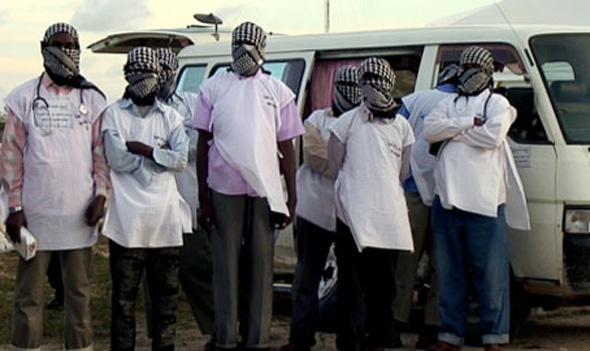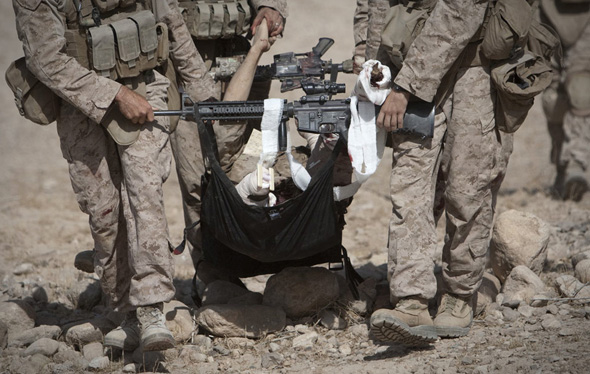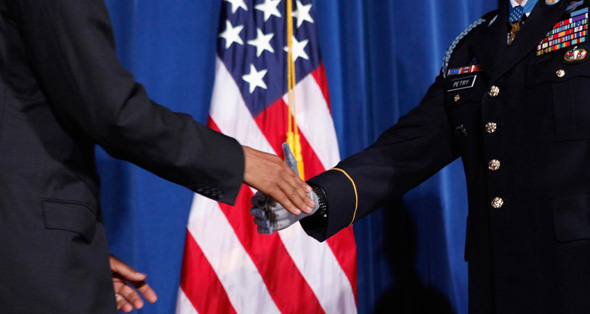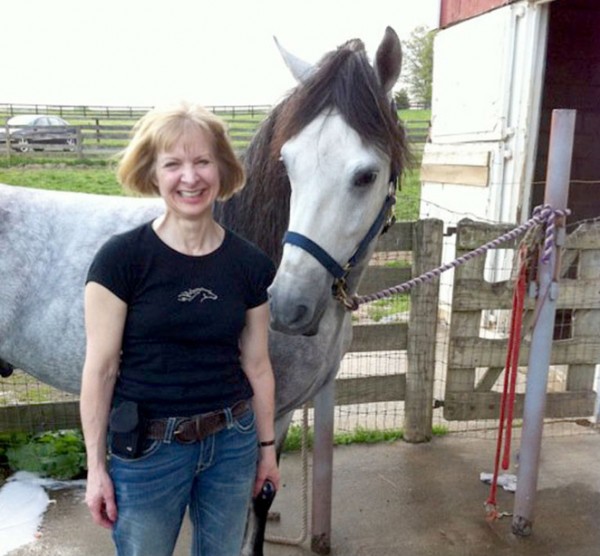Notes
The Elusive Enemy: A Look Back at the Visual Culture of the “War on Terror”
Last week The Guardian published an extraordinary report on how Al Qaeda is using aid to win the ‘hearts and minds’ of displaced Somalis in East Africa’s zone of food insecurity. Jamal Osman’s investigation – including a compelling eleven minute video – reveals how aid workers and medical units, including American and British citizens, are making food and money available in a refugee camp in southern Somalia.
What is striking about the photographs and video that Osman’s team produced is the way the Al Qaeda unit is both present and absent. While their aid distribution was a carefully orchestrated media event, with their leader reading a prepared statement to a group of journalists, the Al Qaeda personnel remained shrouded in scarves obscuring their faces throughout.
Al Qaeda’s elusiveness is something that has marked the decade long ‘war on terror’. After ten years of conflict in Afghanistan and Iraq, the US-led military interventions that made those countries the front line are slowly being wound up. What began with the October 2001 launch of Operation Enduring Freedom in Afghanistan is now the United States’ longest war, and the American commitment is being scaled back as part of the transition to Afghan security control by December 2014. In Iraq the change is swifter, with President Obama announcing last month US combat forces will withdraw from the country by years’ end.
These changes provide useful markers against which to think about the visual culture of conflict, specifically the ‘war on terror, over the last decade. As this post will argue, focusing on news photography and photojournalism, the visual culture of the ‘war on terror’ over the last ten years can be understood as both beginning and ending with absence.
As a response to the attacks of 11 September 2001, the ‘war on terror’ was inaugurated in President Bush’s congressional address on 20 September 2001. Denoting the attacks as an “act of war,” Bush mapped a moral geography in which an axis of evil divided those who were with America from those in conflict with America. This moral geography was heavily indebted to notions of identity/difference that have historically driven US foreign policy. It also constructed a narrative of terror that obscured other potential points of origin for a war, such as the 1993 bombing of the World Trade Center, the 1998 East African embassy bombings, or Osama Bin Laden’s declaration of a jihad against Jews and Crusaders that preceded those attacks (as detailed in Stuart Elden’s Terror and Territory).
Because the ‘war on terror’ was understood as a new type of conflict, fought against an “elusive enemy” in disparate and dispersed locations, visualizing the event was always going to be a challenge. Through its enactment as a response to something real yet virtual, the ‘war on terror’ was an event that both privileged representation yet made representation difficult. What overcame thisaporia is the way the ‘war on terror’ has, for us, been largely framed by US-led military action, such that the overwhelming majority of photographs we associate with the ‘war on terror’ are both concerned with and part of US-led military action that began with the 7 October 2011 attack on Al-Qaeda targets in Afghanistan.
It is common to identify the embedding of journalists and photographers with US and allied forces as the primary reason for the affinities between images and strategy (which is something I debated with Tim Hetherington). Embedding has played a significant role in the visualisation of Afghanistan, though not from the beginning, because when Operation Enduring Freedom began the Pentagon had not yet conceived the specific system. Moreover, given that the first military operations in Afghanistan were covert actions by Special Forces against a non-state actor, embedding was from the military’s viewpoint untenable. As a result, the US-led strikes in Afghanistan proceeded with minimal media access but there were few if any serious protests about this lack.
The early photographic coverage of Afghanistan was, therefore, part of the overall coverage of the ‘war on terror’ arising from the 11 September attacks. Photography is deployed to mark globally significant events, and some US newspapers underwent a “sea change” in their use of news pictures, doubling the number published after 9/11. Part of this proliferation of images was the use of pictures that, while showing something from the general area of operations, did not depict the specific events being reported. This symbolic function, where the repetition of icons associated with 9/11 provided cues and prompts for viewers, meant photographs became a means of moving the public through its trauma, enabling support for the military action in Afghanistan.
A severely wounded US Marine hit by an Improvised Explosive Device (IED) is carried by his comrades to a medevac helicopter of U.S. Army’s Task Force Lift “Dust Off”, Charlie Company 1-171 Aviation Regiment to be airlifted in Helmand province, on October 31, 2011. The Marine was hit by an IED, lost both his legs and fights for his life. Photo: Behrouz Mehri/AFP/Getty Images, via In Focus/The Atlantic, 2 November 2011.
What we have come to see from Afghanistan is a steady stream of familiar pictures made up of allied forces, Afghan civilians, Taliban casualties and American military families (the monthly galleries atThe Atlantic offer examples). Of course there are exceptions, and very occasionally we get to see things from the other side. But generally photojournalism on the front line has focused on the military struggles of international forces as they combat an elusive opponent, with allied soldiers and their weaponry front and centre. Much the same can be said of the visualisations of Iraq since 2003.
Coverage of the invasion of Iraq demonstrated the value to government of the embedding process (although Simon Norfolk has demonstrated being embedded does not preclude making photographic work that questions government policy). Michael Griffin’s survey of US news magazine photographs showed “a highly restricted pattern of depiction limited largely to a discourse of military technological power and response.” However, while the number of combat photographs from Iraq increased from those published in the 1991 Gulf War, they still only comprised ten percent of published pictures. This was less than expected from front-line reportage, and demonstrates that news pictures are less concerned with the first-hand recording of events and more with the repetition of familiar subjects and themes. While individual photographers felt they operated with freedom within the system of embedding, and sometimes even broke the rules, the way their pictures were used in publications did not challenge the official war narrative. That is because the news photographs the public ends up seeing are chosen less for their descriptive function or disruptive potential and more for their capacity to provide symbolic markers to familiar interpretations and conventional narratives.
U.S. President Barack Obama shakes the prosthetic hand of Medal of Honor award recipient U.S. Army Sergeant 1st Class Leroy Petry after he introduced Obama to speak at the American Latino Heritage Forum in Washington, D.C., on October 12, 2011. SFC Petry lost his right hand tossing away a grenade to save his fellow soldiers during combat in Afghanistan. Photo: Reuters/Kevin Lamarque, via In Focus/The Atlantic, 2 November 2011.
As a result, much of our media operates within the limits of official discourse, with journalists working on the field of perception through commitments to their national frames (something apparent in images of official ceremonies with their symbols of sovereignty, as in the Kevin Lamarque/Reuters photograph of a Medal of Honor recipient). Although we still harbour a belief that journalism is indebted to the ethos of the Pentagon Papers or Watergate, fearlessly investigating government failings, much contemporary war coverage directly or indirectly supports military strategies. For example, although British television broadcasters exhibit more faith in the idea of impartiality when compared to the overt patriotism of their American counterparts, a review of their Iraq invasion coverage found that “when it came to contentious issues such as WMDs or the mood of the Iraqi people…overall, all the main television broadcasters tended to favour the pro-war, government version over more sceptical accounts.”
Throughout the last decade, whatever the intentions of individual practitioners, news photography has re-presented the ‘war on terror’, in the form of military action in Afghanistan and Iraq, in ways consistent with military strategy. Much photojournalism exists within and reproduces an ‘eternal present’, obscuring the frames that narrow its perspective, rendering casualties and context as absent. Nowhere was this clearer than in the official White House photo of Osama Bin Laden’s killing. Instead of releasing an image of Bin Laden, what we saw was the Obama national security team in the Situation Room watching a monitor on which the event might have been unfolding. The centrality of absence to the visualisation of the war on terror could not have been more obvious.
Embedded journalism has contributed to this confined view, but this practice has also been constrained by the way the media generally offers a limited challenge to established positions. In this context, calling for an unsanitized view of the war is bound to be insufficient as a strategy for challenging the official photographic narratives. What we require is the exposure of all the frames involved in the production of the field of perceptible reality. To that end, enacting an alternative view requires an aesthetic strategy that draws history into view, pluralizes perspectives, and seeks to overcome the absences that have marked the pictorial coverage to date. Given that the struggle with Al Qaeda will outlast the American withdrawal from both Afghanistan and Iraq, this will be an on-going project.
— David Campbell
This post is based on an editorial written for e-IR.info, and cross-posted at David Campbell’s blog with permission.
Featured top photo: Al-Qaida medical workers at Ala-Yasir camp in Somalia, also known as K50.Jamal Osman for the Guardian.





Reactions
Comments Powered by Disqus